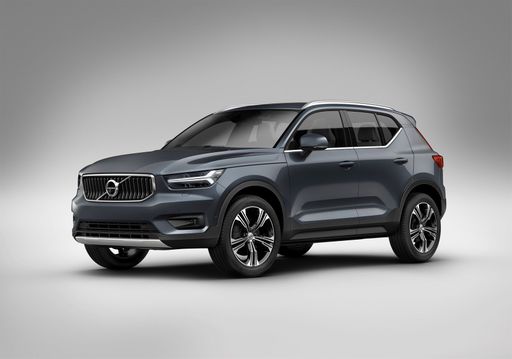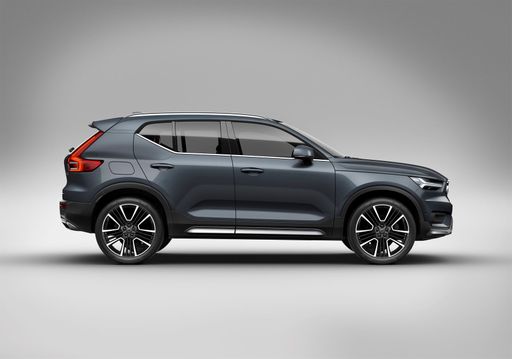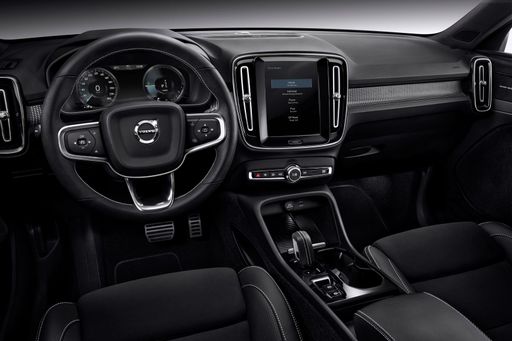Mercedes Sprinter Bus vs Volvo XC40 – Differences & prices compared
Compare performance, boot space, consumption and price in one view.
Find out now: which car is the better choice for you – Mercedes Sprinter Bus or Volvo XC40?
The Mercedes Sprinter Bus (Bus) comes with a Diesel engine and Manuel or Automatic transmission. In comparison, the Volvo XC40 (SUV) features a Petrol MHEV engine with Automatic transmission.
When it comes to boot capacity, the Mercedes Sprinter Bus offers , while the Volvo XC40 provides 452 L – depending on how much space you need. If you’re looking for more power, decide whether the 190 HP of the Mercedes Sprinter Bus or the 197 HP of the Volvo XC40 suits your needs better.
In terms of consumption, the values are 9.30 L per 100 km for the Mercedes Sprinter Bus, and 6.50 L for the Volvo XC40.
Price-wise, the Mercedes Sprinter Bus starts at 41400 £, while the Volvo XC40 is available from 36400 £. Compare all the details and find out which model fits your lifestyle best!
Mercedes Sprinter Bus
The Mercedes-Benz Sprinter Bus stands out as a versatile option for those seeking both comfort and practicality in a people mover. Its spacious interior design ensures ample room for passengers while maintaining a smooth and efficient driving experience. With its advanced safety features and modern amenities, the Sprinter Bus continues to be a leader in its class.
detailsVolvo XC40
The Volvo XC40 is a standout model in the compact SUV segment, offering a delightful blend of Scandinavian design and practicality. Its interior is both stylish and functional, featuring premium materials and innovative storage solutions that make every journey comfortable. The car's performance is smooth and responsive, with advanced safety features ensuring peace of mind for drivers and passengers alike.
details @ media.volvocars.com
@ media.volvocars.com
 @ media.volvocars.com
@ media.volvocars.com
 @ media.volvocars.com
@ media.volvocars.com
 @ media.volvocars.com
@ media.volvocars.com
 @ media.volvocars.com
@ media.volvocars.com

|
|
|
|
|
Costs and Consumption |
|
|---|---|
|
Price
41400 - 55900 £
|
Price
36400 - 47200 £
|
|
Consumption L/100km
9.3 - 12.3 L
|
Consumption L/100km
6.50 L
|
|
Consumption kWh/100km
-
|
Consumption kWh/100km
-
|
|
Electric Range
-
|
Electric Range
-
|
|
Battery Capacity
-
|
Battery Capacity
-
|
|
co2
244 - 322 g/km
|
co2
147 - 148 g/km
|
|
Fuel tank capacity
71 L
|
Fuel tank capacity
54 L
|
Dimensions and Body |
|
|---|---|
|
Body Type
Bus
|
Body Type
SUV
|
|
Seats
2
|
Seats
5
|
|
Doors
4
|
Doors
5
|
|
Curb weight
2356 - 2559 kg
|
Curb weight
1688 kg
|
|
Trunk capacity
-
|
Trunk capacity
452 L
|
|
Length
5932 - 6967 mm
|
Length
4425 mm
|
|
Width
1993 mm
|
Width
1863 mm
|
|
Height
2633 - 2659 mm
|
Height
1652 mm
|
|
Payload
814 - 1144 kg
|
Payload
532 kg
|
Engine and Performance |
|
|---|---|
|
Engine Type
Diesel
|
Engine Type
Petrol MHEV
|
|
Transmission
Manuel, Automatic
|
Transmission
Automatic
|
|
Transmission Detail
Manual Gearbox, Automatic Gearbox
|
Transmission Detail
Dual-Clutch Automatic
|
|
Drive Type
Rear-Wheel Drive, All-Wheel Drive
|
Drive Type
Front-Wheel Drive
|
|
Power HP
114 - 190 HP
|
Power HP
163 - 197 HP
|
|
Acceleration 0-100km/h
-
|
Acceleration 0-100km/h
7.6 - 8.6 s
|
|
Max Speed
150 - 159 km/h
|
Max Speed
180 km/h
|
|
Torque
300 - 450 Nm
|
Torque
265 - 300 Nm
|
|
Number of Cylinders
4
|
Number of Cylinders
4
|
|
Power kW
84 - 140 kW
|
Power kW
120 - 145 kW
|
|
Engine capacity
1950 cm3
|
Engine capacity
1969 cm3
|
General |
|
|---|---|
|
Model Year
2024 - 2025
|
Model Year
2024
|
|
CO2 Efficiency Class
G
|
CO2 Efficiency Class
E
|
|
Brand
Mercedes-Benz
|
Brand
Volvo
|
Mercedes Sprinter Bus
The Mercedes-Benz Sprinter Bus: A Revolution in Transport
The Mercedes-Benz Sprinter Bus has long been a symbol of efficiency and reliability. Renowned for its versatility and performance, Mercedes-Benz continues to push boundaries with its latest models, catering to the needs of businesses and individuals alike. Whether used for passenger transport or as a corporate shuttle, the Sprinter Bus offers an exceptional driving experience, combining innovative technology with superior comfort.
Engineering Excellence: Under the Bonnet
At the heart of the Mercedes-Benz Sprinter Bus is its robust engine lineup, offering power outputs ranging from 114 PS to an impressive 190 PS. These variants ensure that there is a model suitable for every requirement, whether you need efficient city commuting or robust highway cruising.
The Sprinter Bus is equipped with either a manual or automatic transmission, providing flexibility to suit different driving preferences. The sophisticated 9G-TRONIC automatic gearbox represents a pinnacle of automotive engineering, ensuring smooth and efficient gear changes, which enhance the overall driving experience.
Performance and Efficiency: Meeting Environmental Standards
The Sprinter Bus's diesel engines are not just about power; they also focus on fuel efficiency, with consumption figures between 9.3 L/100km and 12.3 L/100km. The inclusion of start/stop technology helps in reducing fuel consumption, thus making it more economical and environmentally friendly.
Mercedes-Benz shows its commitment to sustainability by ensuring all engine options comply with stringent emissions standards. The models provide a CO2 efficiency class of G, underlining the brand's dedication to creating vehicles that are as kind to the planet as they are to your pocket.
Design and Comfort: Where Function Meets Style
The design of the Mercedes-Benz Sprinter Bus effortlessly combines functionality with aesthetics. The interior space is crafted to provide maximum comfort for passengers, while the exterior design leaves a lasting impression with its sleek lines and authoritative presence.
The Sprinter Bus can accommodate up to nine seats, making it ideal for passenger transport. Options such as air conditioning, advanced infotainment systems, and ergonomic seating ensure a pleasant experience for both driver and passengers, even on long journeys.
Safety and Technology: Prioritising Your Well-being
The Sprinter Bus offers a suite of advanced safety features aimed at keeping occupants safe, including adaptive cruise control, lane keep assist, and crosswind assist. These features are integrated with cutting-edge technology, such as the Mercedes-Benz User Experience (MBUX) system, which enhances connectivity and user interaction.
With rear-wheel drive and optional all-wheel drive capabilities, the Sprinter Bus is equipped to handle a variety of terrains and weather conditions, providing reassurance for every journey.
The Future of Transport: Innovative Options
Mercedes-Benz demonstrates their innovative edge with customisation options tailored to various business needs, be it for luxury transport or robust utility. Additionally, the Sprinter Bus's load capacity ranges from 814 kg to 1,249 kg, ensuring businesses can meet their logistical needs efficiently.
As demands for sustainable transport solutions grow, the Sprinter Bus is positioned as a forward-looking vehicle that blends traditional Mercedes-Benz quality with modern innovations.
The Mercedes-Benz Sprinter Bus is more than just a vehicle; it is an investment in exceptional performance and unmatched adaptability, engineered to meet the diverse demands of today's transport sector. From its powerful yet efficient engines to its state-of-the-art technology and safety features, the Sprinter remains a leader in its class.
Volvo XC40
Introduction: The Refined Volvo XC40
The Volvo XC40 is a testament to Swedish innovation and design, blending practicality with cutting-edge technology in the compact SUV segment. Aimed at drivers who value safety, comfort, and eco-conscious driving, the XC40 continues to uphold Volvo's reputation for engineering excellence. In this article, we'll explore the technical specifications and innovative features that make the XC40 a standout choice for modern drivers.
Power and Performance
Under the bonnet, the Volvo XC40 offers a range of mild-hybrid petrol engines, combining efficiency with a responsive driving experience. The power output ranges from 163 to 197 PS (120 to 145 kW), ensuring robust performance for both urban commuting and longer journeys. With a maximum torque of 265 to 300 Nm, the vehicle offers smooth acceleration, achieving 0-100 km/h in just 7.6 to 8.6 seconds, whilst maintaining a CO2 efficiency class of E.
Efficiency Meets Eco-Conscious Design
The mild-hybrid system in the XC40 effectively reduces fuel consumption, with an impressive average of 6.5 L/100km. The system recycles braking energy to charge the battery, reducing emissions to between 147-148 g/km without compromising on performance. This design aligns perfectly with Volvo's commitment to sustainable motoring.
Cutting-Edge Transmission
The XC40 is equipped with an advanced automatic dual-clutch transmission that seamlessly transitions through gears, enhancing both fuel efficiency and driving comfort. The integration of this technology underscores Volvo’s commitment to delivering an engaging yet smooth driving experience.
Sophisticated Interior Design
The interior of the XC40 reflects Volvo’s dedication to Scandinavian design aesthetics, featuring a spacious cabin with high-quality materials. The vehicle comfortably seats five passengers, with a versatile boot space of 452 litres, making it ideal for family outings or road trips. The intuitive infotainment system is seamlessly integrated, providing driver-friendly access to navigation, entertainment, and safety features.
Safety Innovations
Volvo’s renowned safety reputation is evident in the XC40’s comprehensive suite of safety features. Advanced driver assistance systems, including adaptive cruise control, blind-spot monitoring, and lane-keeping aid, ensure a secure driving environment. The XC40’s construction and technology adhere to Volvo's “Vision 2020” strategy, aiming for zero fatalities or serious injuries in new Volvo cars.
Conclusion: A Contemporary Choice
The Volvo XC40 stands out as a compact SUV that blends innovation, efficiency, and style. Its proactive approach to hybrid technology, coupled with Volvo’s trademark focus on safety and design, makes it a compelling choice for those seeking a blend of practicality and performance. Whether it’s the daily commute or a weekend getaway, the XC40 is engineered to deliver a dynamic and sustainable driving experience.
The prices and data displayed are estimates based on German list prices and may vary by country. This information is not legally binding.
